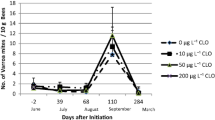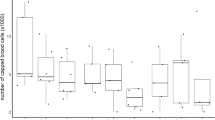Abstract
Alleviating nutritional stress in European honeybee hives helps to increase resilience to parasite infections and reduces the interactive effects of pesticides. Here, we used a field experiment to evaluate the effectiveness of floral enhancement in reducing bee exposure to insecticides. A mass-flowering crop, white mustard, was cultivated in a small patch near an experimental apiary comprising 10 hives. To assess the frequency of floral patch use by bees in each hive, we attached electronic tags to bees foraging on white mustard flowers and then recorded the number of tagged bees in each hive a day before insecticide spraying in the adjacent paddy fields. The number of corpses around hive entrances increased within a day after the spraying but varied among hives. There was a significant negative correlation between the number of tagged bees and the cumulative number of corpses at each hive. We suggest that attracting foraging bees to mass-flowering resources near an apiary helps to reduce insecticide exposure risk.

source was the topographic data from the Fundamental Geospatial Data developed by the Geospatial Information Authority of Japan



Similar content being viewed by others
References
Alaux C, Ducloz F, Crauser D, Le Conte Y (2010) Diet effects on honeybee immunocompetence. Biol Lett 6:562–565
Alaux C, Allier F, Decourtye A, Odoux J-F, Tamic T, Chabirand M, Delestra E, Decugis F, Le Conte Y, Henry M (2017) A ‘landscape physiology’ approach for assessing bee health highlights the benefits of floral landscape enrichment and semi-natural habitats. Sci Rep 7:40568
Balfour NJ, Ollerton J, Castellanos MC, Ratnieks FLW (2018) British phenological records indicate high diversity and extinction rates among late-summer-flying pollinators. Biol Conserv 222:278–283
Blacquière T, Smagghe G, van Gestel CAM, Mommaerts V (2012) Neonicotinoids in bees: a review on concentrations, side-effects and risk assessment. Ecotoxicology 21:973–992
Bretagnolle V, Gaba S (2015) Weeds for bees? A review. Agron Sustain Dev 35:891–909
Couvillon MJ, Fensome KA, Quah SK, Schürch R (2014) Summertime blues. Commun Integr Biol 7:e28821
Decourtye A, Mader E, Desneux N (2010) Landscape enhancement of floral resources for honey bees in agro-ecosystems. Apidologie 41:264–277
Decourtye A, Devillers J, Aupinel P, Brun F, Bagnis C, Fourrier J, Gauthier M (2011) Honeybee tracking with microchips: a new methodology to measure the effects of pesticides. Ecotoxicology 20:429–437
Di Pasquale G, Alaux C, Le Conte Y, Odoux J-F, Pioz M, Vaissière BE, Belzunces LP, Decourtye A (2016) Variations in the availability of pollen resources affect honey bee health. PLoS ONE 11:e0162818
Dolezal AG, Toth AL (2018) Feedbacks between nutrition and disease in honey bee health. Curr Opin Insect Sci 26:114–119
Dolezal AG, Carrillo-Tripp J, Miller WA, Bonning BC, Toth AL (2016) Intensively cultivated landscape and Varroa mite infestation are associated with reduced honey bee nutritional state. PLoS ONE 11:e0153531
Dolezal AG, St. Clair AL, Zhang G, Toth AL, O’Nea ME (2019) Native habitat mitigates feast–famine conditions faced by honey bees in an agricultural landscape. Proc Natl Acad Sci 116:25147–25155
Gill RJ, Ramos-Rodriguez O, Raine NE (2012) Combined pesticide exposure severely affects individual- and colony-level traits in bees. Nature 491:105–108
González-Varo JP, Biesmeijer JC, Bommarco R, Potts SG, Schweiger O, Smith HG, Steffan-Dewenter I, Szentgyörgyi H, Woyciechowski M, Vilà M (2013) Combined effects of global change pressures on animal-mediated pollination. Trends Ecol Evol 28:524–530
Goulson D, Nicholls E, Botias C, Rotheray EL (2015) Bee declines driven by combined stress from parasites, pesticides, and lack of flowers. Science 347:1255957
Iwasa T, Motoyama N, Ambrose JT, Roe RM (2004) Mechanism for the differential toxicity of neonicotinoid insecticides in the honey bee, Apis mellifera. Crop Prot 23:371–378
Johnson B (2002) Reallocation of labor in honeybee colonies during heat stress: the relative roles of task switching and the activation of reserve labor. Behav Ecol Sociobiol 51:188–196
Kamo T, Kusumoto Y, Tokuoka Y, Okubo S, Hayakawa H, Yoshiyama M, Kimura K, Konuma A (2018) A DNA barcoding method for identifying and quantifying the composition of pollen species collected by European honeybees, Apis mellifera (Hymenoptera: Apidae). Appl Entomol Zool 53:353–361
Kimura K, Yoshiyama M, Saito K, Nirasawa K, Ishizaka M (2014) Examination of mass honey bee death at the entrance to hives in a paddy rice production district in Japan: the influence of insecticides sprayed on nearby rice fields. J Apic Res 53:599–606
Kiritani K (2007) The impact of global warming and land-use change on the pest status of rice and fruit bugs (Heteroptera) in Japan. Glob Chang Biol 13:1586–1595
Kühnholz S, Seeley TD (1997) The control of water collection in honey bee colonies. Behav Ecol Sociobiol 41:407–422
Mosqueiro T, Cook C, Huerta R, Gadau J, Smith B, Pinter-Wollman N (2017) Task allocation and site fidelity jointly influence foraging regulation in honeybee colonies. R Soc Open Sci 4:170344
Odoux JF, Feuillet D, Aupinel P, Loublier Y, Tasei JN, Mateescu C (2012) Territorial biodiversity and consequences on physico-chemical characteristics of pollen collected by honey bee colonies. Apidologie 43:561–575
Okubo S, Nikkeshi A, Tanaka CS, Kimura K, Yoshiyama M, Morimoto N (2019) Forage area estimation in European honeybees (Apis mellifera) by automatic waggle decoding of videos using a generic camcorder in field apiaries. Apidologie 50:243–252
Okubo S, Yoshiyama M, Nikkeshi A, Morimoto N, Kimura K (2020) Effect of cold narcosis on foraging behavior of European honey bees (Apis mellifera ligustica Spinola) tracked using a radio-frequency identification (RFID) system. J Api Res. https://doi.org/10.1080/00218839.2020.1771879
Potts SG, Biesmeijer JC, Kremen C, Neumann P, Schweiger O, Kunin WE (2010) Global pollinator declines: trends, impacts and drivers. Trends Ecol Evol 25:345–353
R Core Team (2018) R: a language and environment for statistical computing. R Foundation for Statistical Computing, Vienna
Rader R, Howlett BG, Cunningham SA, Westcott DA, Newstrom-Lloyd LE, Walker MK, Teulon DAJ, Edwards W (2009) Alternative pollinator taxa are equally efficient but not as effective as the honeybee in a mass flowering crop. J Appl Ecol 46:1080–1087
Requier F, Odoux J-F, Tamic T, Moreau N, Henry M, Decourtye A, Bretagnolle V (2015) Honey bee diet in intensive farmland habitats reveals an unexpectedly high flower richness and a major role of weeds. Ecol Appl 25:881–890
Rodney S, Purdy J (2020) Dietary requirements of individual nectar foragers, and colony-level pollen and nectar consumption: a review to support pesticide exposure assessment for honey bees. Apidologie. https://doi.org/10.1007/s13592-019-00694-9
Rollin O, Bretagnolle V, Decourtye A, Aptel J, Michel N, Vaissière BE, Henry M (2013) Differences of floral resource use between honey bees and wild bees in an intensive farming system. Agric Ecosyst Environ 179:78–86
Sanchez-Bayo F, Goka K (2014) Pesticide residues and bees: a risk assessment. PLoS ONE 9:e94482
Schmehl DR, Teal PEA, Frazier JL, Grozinger CM (2014) Genomic analysis of the interaction between pesticide exposure and nutrition in honey bees (Apis mellifera). J Insect Physiol 71:177–190
Seeley TD, Camazine S, Sneyd J (1991) Collective decision-making in honey bees: how colonies choose among nectar sources. Behav Ecol Sociobiol 28:277–290
Sponsler DB, Grozinger CM, Hitaj C, Rundlöf M, Botías C, Code A, Lonsdorf EV, Melathopoulos AP, Smith DJ, Suryanarayanan S, Thogmartin WE, Williams NM, Zhang M, Douglas MR (2019) Pesticides and pollinators: a socioecological synthesis. Sci Total Environ 662:1012–1027
Streit S, Bock F, Pirk CWW, Tautz J (2003) Automatic life-long monitoring of individual insect behaviour now possible. Zoology 106:169–171
Thorbek P, Campbell PJ, Sweeney PJ, Thompson HM (2017) Using BEEHAVE to explore pesticide protection goals for European honeybee (Apis melifera L.) worker losses at different forage qualities. Environ Toxicol Chem 36:254–264
Visscher PK (1983) The honey bee way of death: necrophoric behaviour in Apis mellifera colonies. Anim Behav 31:1070–1076
Wood TJ, Kaplan I, Szendrei Z (2018) Wild bee pollen diets reveal patterns of seasonal foraging resources for honey bees. Front Ecol Evol 6:210
Acknowledgements
This research was partly supported by grants from a project of the Bio-oriented Technology Research Advancement Institution, NARO (Special Scheme Project on Vitalizing Management Entities of Agriculture, Forestry and Fisheries) and JSPS KAKENHI Grant Number 20K06118. We thank Yasuyuki Hasada, Yosuke Hasada, and Nobuyuki Murakami for their kind cooperation in establishing and managing an experimental apiary in Hokkaido; all staff of the Fujiwara farm for kindly offering their lands for the experimental apiary and white mustard cultivation; Katsuya Ejiri and other project members for helping with data collection; and two anonymous reviewers for helpful comments.
Author information
Authors and Affiliations
Corresponding author
Ethics declarations
Conflict of interest
The authors declare that they have no competing interests.
Additional information
Publisher's Note
Springer Nature remains neutral with regard to jurisdictional claims in published maps and institutional affiliations.
Rights and permissions
About this article
Cite this article
Okubo, S., Shoji, A., Kimura, K. et al. Effectiveness of floral enhancement in reducing honeybee exposure to insecticides. Appl Entomol Zool 56, 207–215 (2021). https://doi.org/10.1007/s13355-021-00727-9
Received:
Accepted:
Published:
Issue Date:
DOI: https://doi.org/10.1007/s13355-021-00727-9




